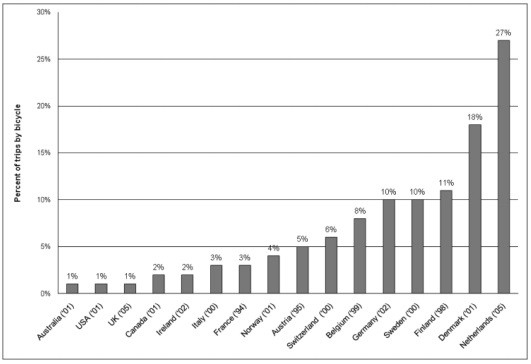
Serious policy debates about urban transport invariably come down to the relative merits of cars versus public transport. More trains and more light rail (but only occasionally more buses) are favoured as the way for Australian cities to grow and at least maintain their liveability.
The bicycle is almost always relegated to a minor role; perhaps a few percentage points mode share at best. Yet we know from experience elsewhere that it’s possible, given particular conditions, for cycling to make a much bigger contribution to the urban travel task.
In metropolitan Copenhagen, for example, bicycles account for around 20% of all trips (1). In Dutch cities it’s even higher – around 40% in Amsterdam and Assen and almost 60% in Groningen.
That’s much higher than public transport’s share in Australian cities. Averaged across Australia’s capital cities, public transport accounts for around 11% of all travel. It’s higher in some cities and lower in others e.g. around 14% in Sydney and 8% in Brisbane (2).
Both public transport and cars will be an important part of how Australian cities deal in the future with a growing population, but I think the potential of cycling as a policy ‘solution’ is often seriously underestimated.
It’s well established that bicycles have a low impact on the environment, require little road and parking space, and on their own account almost never suffer serious congestion.
If they can be separated from general traffic as they are in many Dutch cities, they’re exceptionally safe. Indeed, the level of subjective safety is so high in the Netherlands that hardly any cyclists wear a helmet.
The advent of low-cost, efficient power assistance now means bicycles can travel long distances without raising an uncomfortable sweat. They can also be ridden by people with compromised fitness.
Compared to a speedy car, bicycles can be costly in terms of time lost in travel. But with rising density and congestion, bicycles are increasingly more time-competitive with cars for a large proportion of urban journeys.
All that’s well known. But there are two key reasons to be bullish about the potential of bicycles.
The first one is that cycling is a private form of transport. Travellers in rich countries like Australia have shown that, given the option, they much prefer private transport over shared (public) transport.
Like a car, a bicycle is available on-demand. There’s no waiting; service frequency and span of hours don’t matter. It goes straight to the traveller’s destination without deviation, without stopping, and without the need to transfer. Importantly, like a car, it isn’t shared with strangers.
Bicycles are very much like cars. Given safe conditions and the option of power assistance for those who want it, I think bicycles (and scooters and small motor cycles) can compete more effectively with cars for many journeys than public transport.
Public transport is hard to beat for accessing highly concentrated destinations like the CBD, especially from more distant origins. But it’s very hard for it to compete cost-effectively against private forms of transport for the sorts of trips between dispersed origins and destinations that now characterise most urban travel.
The second reason is that the social and private costs of cycling are exceptionally low. Relative to a car, a bicycle has very few negative externalities. Even an electrically-assisted bicycle generates limited pollution, emissions and noise.
Relative to public transport cycling requires little public subsidy (in NSW each rail journey costs taxpayers $10 on average). As with cars, most of the financial costs are paid by the traveller.
Except for roads – which are necessary anyway for emergency vehicles, freight and amenity – bicycles impose little cost on the budget. Dedicated bicycle “roads” are cheap to build and maintain; they don’t need the pavement strength, the width, or the generous curve radii of roads.
Getting an order-of-magnitude increase in cycling’s mode share requires two things. One is that cars must be less competitive. There’s a good chance that will happen organically due to traffic congestion but it can and should be encouraged by regulatory and taxation policies e.g. congestion pricing.
The other is safety. Bicycles need to be separated from cars, trucks and buses. That’s been the key to the bicycle’s success in the Netherlands. Since cyclists and drivers will nevertheless need to share road space for the foreseeable future, driving also needs to be “reinvented” as an activity that sits lower in the pecking order than cycling and walking.
Extracting the potential benefits of cycling isn’t likely to come painlessly. A big increase in mode share will to a large degree come at the expense of motorists. That will mainly be in the form of roadspace reallocated to cycling and as a consequence of rules that modify the behaviour of drivers.
It’s not necessary or probably even realistic to expect cycling in Australian cities to match what’s happened in Dutch cities. After all, there’re large differences between cities even in countries with an established cycling culture. However a mode share that (say) came close to public transport’s current share would make an enormous difference to Australian cities (3)
_____________________________________
- You’ll see much higher figures tossed around for Copenhagen but these can be misleading. They refer to only certain types of trip (e.g. work and education) or to small geographies (e.g. juts the central part i.e. City of Copenhagen).
- For convenience, I’ve used shares of travel (i.e. kilometres); if measured in terms of numbers of trips, public transport’s mode share would be a little lower.
- I’m aware that much of the potential of cycling also applies to scooters and small motor cycles, perhaps even more. There are issues though, including differences in speed and access to dedicated infrastructure like off-road trails and bicycle lanes.








Crikey encourages robust conversations on our website. However, we’re a small team, so sometimes we have to reluctantly turn comments off due to legal risk. Thanks for your understanding and in the meantime, have a read of our moderation guidelines.